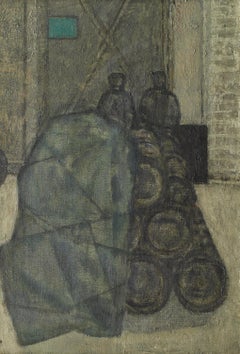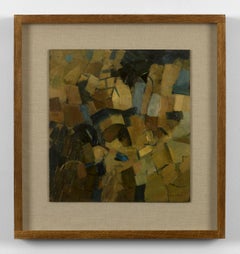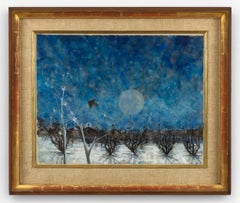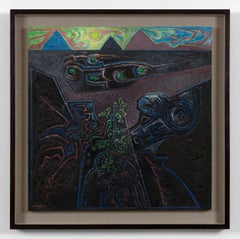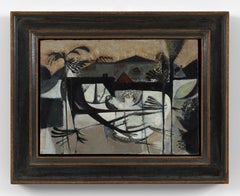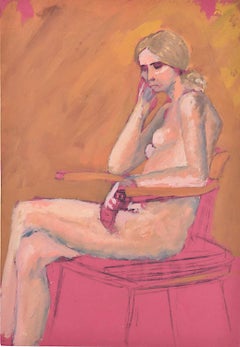Osborne Samuel Gallery Landscape Paintings
11
6
9
2
1
4
2
1
3
Overall Height
to
Overall Width
to
9
2
4
3
2
2
2
2
1
1
1
1
1
1
1
1
1
1
1
9
2
3
4
1
1
2
2
2
1
1
10
7
4
4
3
Barrels in a Yard - 20th Century, Oil on canvas by Prunella Clough
By Prunella Clough
Located in London, GB
Provenance:
Leicester Galleries, London, 1956
Austin Desmond Fine Art, London
Category
1950s Modern Figurative Paintings
Materials
Canvas, Oil
Landscape - 20th Century, Oil on board by Keith Vaughan
By Keith Vaughan
Located in London, GB
Signed lower right.
From the later 1950s, Vaughan painted landscapes without figures that verged towards complete abstraction: works in which colour is tessellated into compositions ...
Category
1960s Modern Landscape Paintings
Materials
Oil, Board
Legend in December - 20th Century, Watercolour on paper by Alan Reynolds
By Alan Reynolds
Located in London, GB
Signed and dated Reynolds 55 lower left. Also signed, dated and titled in pencil verso.
Reynolds’ intense study of nature led him to create sketchbooks filled with botanical studies, pressed leaves, grasses, seedpods and feathers – forms upon which he based abstract landscapes during the first, figurative stage of his career. Among the most significant sequence of paintings derived from these studies was ‘The Four Seasons’, showing landscape transformed across the cycle of the year.
Legend in December (1955) relates to this series, showing a winter landscape in which the moon hangs low over the horizon. Bushes cast pallid shadows, and whitened seed heads appear like fireworks against the sky. On the roof of a chapel, haloed, is a cross mirrored...
Category
1950s Modern Landscape Paintings
Materials
Watercolor, Gouache
Rocky Sheepfold - 20th Century, Gouache and ink on paper by John Piper
By John Piper
Located in London, GB
Signed lower right in ink, titled verso.
In 1943 Piper received a commission to document a slate quarry inside the mountain of Manod Mawr, north Wales, where the collections of the N...
Category
1940s Modern Landscape Paintings
Materials
Ink, Gouache
Volcanic Landscape - 20th Century, Tempera on board by John Craxton
By John Craxton
Located in London, GB
Tempera and volcanic ash on board.
Signed lower left; also signed, titled and dated 1973 verso.
Category
1970s Modern Landscape Paintings
Materials
Tempera, Board
Moth Barn Interior 3 - 20th Century, Oil on board by Alan Reynolds
By Alan Reynolds
Located in London, GB
Oil on board, signed verso.
Reynolds made numerous paintings on the theme of ‘moth barn’, in addition to a lithograph dating from 1956. Moth Barn Interior 3 (1952) is a diminutive va...
Category
1950s Modern Landscape Paintings
Materials
Oil, Board
Landscape (Spetses, Greece) - 20th Century, Mixed media on paper by John Craxton
By John Craxton
Located in London, GB
Mixed technique on paper. Dated lower left in ink: "10.10.46" and signed.
Category
1940s Modern Landscape Paintings
Materials
Mixed Media
Deserted Gravel Pit - 20th Century, Oil on board by Prunella Clough
By Prunella Clough
Located in London, GB
Signed lower right
Provenance:
Austin Desmond Fine Art, London
Private Collection France
Category
1940s Modern Landscape Paintings
Materials
Oil, Board
San Quirico d'Orcia I - 20th Century, Oil on canvas by Joe Tilson
By Joe Tilson
Located in London, GB
Signed and dated 1956 lower left
Also signed, titled, dated 1956 and inscribed verso
Sand has been incorporated into the pigment
Category
1950s Modern Landscape Paintings
Materials
Canvas, Oil
The Sea and the Staircase, Moon Bay, Night - Contemporary, Oil by Keith Grant
Located in London, GB
Signed, inscribed with title and dimensions, and dated 2010 on stretcher.
Category
2010s Contemporary Landscape Paintings
Materials
Canvas, Oil
Track through the Ancient Country - Contemporary, Oil on linen by Rob MacLaurin
Located in London, GB
Signed lower right
Signed, titled and dated verso
Category
Early 2000s Contemporary Landscape Paintings
Materials
Linen, Oil
Related Items
1950's French Modernist/ Cubist Painting signed - Tall French Buildings
By Bernard Labbe
Located in Cirencester, Gloucestershire
Tall French Landscape
by Bernard Labbe (French mid 20th century)
signed original watercolour/ gouache painting on paper , unframed
size: 18.5 x 12.5 inches
condition: very good and r...
Category
Mid-20th Century Modern Landscape Paintings
Materials
Ink, Gouache, Watercolor
Woman sitting: Hilary Hennes Miller c.1940 English Modern British Art
By Hilary Hennes
Located in London, GB
To see our other Modern British Art, including others by Hennes, scroll down to "More from this Seller" and below it click on "See all from this Seller" - or send us a message if you...
Category
1940s Modern Landscape Paintings
Materials
Gouache
"Cloudy Day" Colorful Impressionist Landscape
By Robert Weimerskirch 1
Located in Houston, TX
Abstract impressionist work done in blue and green tones of a cityscape by artist Robert Weimerskirch in 1991. Signed and dated by artist.
Dimens...
Category
1990s Abstract Impressionist Landscape Paintings
Materials
Gouache, Ink
H 23.25 in W 23.25 in D 0.75 in
'Old Fishing Boat', Italian Tuscan School
Located in London, GB
'Old Fishing Boat', oil on canvas, Italian Tuscan School, (1972). Glimmering reflections on the water outline the hull of an old fishing boat in the port...
Category
1970s Modern Landscape Paintings
Materials
Canvas, Oil
Orange Grove Landscape
By Dorr Bothwell
Located in Los Angeles, CA
Orange Grove Landscape, 1941, gouache on illustration board, 14 inches x 18 inches (image), 22 x 26 inches (framed) signed and dated lower right, newly framed with museum glazing
...
Category
1940s American Modern Paintings
Materials
Gouache, Board
1950's French Impressionist Painting Cows Munching In Hay Field Landscape
Located in Cirencester, Gloucestershire
Cows Munching
by Y. Blanchon, French 1950's Impressionist artist
signed gouache on artist paper, unframed
painting: 12.5 x 16 inches
provenance: from a large private collection of th...
Category
Mid-20th Century Modern Landscape Paintings
Materials
Gouache
Figurative landscape oil painting- Purple Memory
Located in Beijing, CN
Dai Xiangwen was born in Hunan in 1991 and graduated from the Academy of Fine Arts of Jianghan University,
He is a member of China Artists Association, China Designers Association, a painter of Li Keran...
Category
2010s Modern Figurative Paintings
Materials
Canvas, Oil
Free Shipping
H 23.63 in W 31.5 in
Pikes Peak, 1940s Colorado Mountain Landscape in Autumn, Tempera Painting
By Charles Ragland Bunnell
Located in Denver, CO
Original vintage 1941 Colorado landscape painting with autumn leaves and Pikes Peak blanketed in snow by Charles Bunnell (1897-1968). Inscribed verso, "To Laura, November 22, 1941", egg tempera on board. Signed by the artist in the lower left corner and titled verso. Presented in a custom frame, outer dimensions measure 15 ½ x 19 ¼ x 1 ¼ inches. Image size is 7 ¾ x 11 inches
About the Artist:
Artist and teacher, Charles ("Charlie") Bunnell worked in a variety of styles throughout his career because as an artist he believed, "I’ve got to paint a thousand different ways. I don’t paint any one way." At different times he did representational landscapes while concurrently involved with semi- or completely abstract imagery. He was one of a relatively small number of artists in Colorado successfully incorporating into their work the new trends emanating from New York and Europe after World War II. During his lifetime he generally did not attract a great deal of critical attention from museums, critics and academia. However, he personally experienced a highpoint in his career when Katherine Kuh, curator at the Art Institute of Chicago, personally chose one of his paintings - Why? - for its large exhibition of several hundred examples of abstract and surrealist art held in 1947-48, subsequently including it among the fifty pieces selected for a traveling show to ten other American museums.
An only child, Bunnell developed his love of art at a young age through frequent drawing and political cartooning. In high school he was interested in baseball and golf and also was the tennis champion for Westport High School in Kansas City. Following graduation, his father moved the family to Denver, Colorado, in 1916 for a better-paying bookkeeping job, before relocating the following year to Colorado Springs to work for local businessman, Edmond C. van Diest, President of the Western Public Service Company and the Colorado Concrete Company. Bunnell would spend almost all of his adult life in Colorado Springs.
In 1918 he enlisted in the United States Army, serving in the 62nd Infantry Regiment through the end of World War I. Returning home with a 10% disability, he joined the Zebulon Pike Post No. 1 of the Disabled American Veterans Association and in 1921 used the benefits from his disability to attend a class in commercial art design conducted under a government program in Colorado Springs. The following year he transferred to the Broadmoor Art Academy (founded in 1919) where he studied with William Potter and in 1923 with Birger Sandzén. Sandzén’s influence is reflected in Bunnell’s untitled Colorado landscape (1925) with a bright blue-rose palette.
For several years thereafter Bunnell worked independently until returning to the Broadmoor Art Academy to study in 1927-28 with Ernest Lawson, who previously taught at the Kansas City Art Institute where Bunnell himself later taught in the summers of 1929-1930 and in 1940-41. Lawson, a landscapist and colorist, was known for his early twentieth-century connection with "The Eight" in New York, a group of forward-looking painters including Robert Henri and John Sloan whose subject matter combined a modernist style with urban-based realism. Bunnell, who won first-place awards in Lawson’s landscapes classes at the Academy, was promoted to his assistant instructor for the figure classes in the 1928-29 winter term. Lawson, who painted in what New York critic James Huneker termed a "crushed jewel" technique, enjoyed additional recognition as a member of the Committee on Foreign Exhibits that helped organize the landmark New York Armory Exhibition in 1913 in which Lawson showed and which introduced European avant-garde art to the American public.
As noted in his 1964 interview for the Archives of American Art in Washington, DC, Bunnell learned the most about his teacher’s use of color by talking with him about it over Scotch as his assistant instructor. "Believe me," Bunnell later said, "[Ernie] knew color, one of the few Americans that did." His association with Lawson resulted in local scenes of Pikes Peak, Eleven Mile Canyon, the Gold Cycle Mine near Colorado City and other similar sites, employing built up pigments that allowed the surfaces of his canvases to shimmer with color and light. (Eleven Mile Canyon was shown in the annual juried show at the Carnegie Institute in Pittsburgh in 1928, an early recognition of his talent outside of Colorado.) At the same time, he animated his scenes of Colorado Springs locales by defining the image shapes with color and line as demonstrated in Contrasts (1929). Included in the Midwestern Artists’ Exhibition in Kansas City in 1929, it earned him the gold medal of the Kansas City Art Institute, auguring his career as a professional artist.
In the 1930s Bunnell used the oil, watercolor and lithography media to create a mini-genre of Colorado’s old mining towns and mills, subject matter spurned by many local artists at the time in favor of grand mountain scenery. In contrast to his earlier images, these newer ones - both daytime and nocturnal -- such as Blue Bird Mine essentially are form studies. The conical, square and rectangular shapes of the buildings and other structures are placed in the stark, undulating terrain of the mountains and valleys devoid of any vegetation or human presence. In the mid-1930s he also used the same approach in his monochromatic lithographs titled Evolution, Late Evening, K.C. (Kansas City) and The Mill, continuing it into the next decade with his oil painting, Pikes Peak (1942).
During the early 1930s he studied for a time with Boardman Robinson, director of the Broadmoor Art Academy and its successor institution, the Colorado Springs Fine Arts Center from 1930 to 1947. In 1934 Robinson gave him the mural commission under the Public Works of Art Project (PWAP) for West Junior High School in Colorado Springs, his first involvement in one of several New Deal art...
Category
1930s American Impressionist Landscape Paintings
Materials
Egg Tempera, Board
H 15.5 in W 19.25 in D 1.25 in
Ireland Landscape Rocky Cliffs with Castle on the Northern Irish Sea Coastline
Located in Preston, GB
Ireland Landscape Rocky Cliffs with Castle on the Northern Irish Sea Coastline, by 20th Century Irish Australian Artist, Henry McLaughlin.
Art measures 10 x 8 inches
Frame measure...
Category
1980s Modern Landscape Paintings
Materials
Oil, Board
Springtime, 1960s Semi Abstract Modernist Mountain Landscape Tempera Painting
By Ethel Magafan
Located in Denver, CO
"Springtime" is an original tempera on board painting of a Colorado mountain landscape painting by Ethel Magafan circa 1960. Abstracted mountain landscape with trees, painted in colors of green, purple, golden yellow, red, orange, blue, black and white. Presented in a custom hardwood frame, outer dimensions measure 23 ¼ x 50 x 2 inches. Image size is 30 x 48 inches.
Provenance: Private collection, Maine
Acquired in the early 1960s, by descent through the family to the present owner
About the Artist:
Jenne and Ethel Magafan were identical twins, born in Chicago to a Greek immigrant father and a Polish mother. Due to health concerns about their father, the family moved to Colorado, living first in Colorado Springs and then in Denver. He was a proud supporter of their artistic ambitions but died suddenly 1932, a heavy blow to both of them. They attended East High School in Denver, where they found a mentor in their art teacher Helen Perry. She had studied at the Art Institute of Chicago but had later abandoned a career as an artist, making her all the more determined to help the Magafan twins succeed artistically.
While still in high school, the twins impressed artist Frank Mechau, and Helen Perry paid for their lessons with him. He subsequently invited them to apprentice with him at his Redstone studio. In 1936, Jenne won the Carter Memorial Art Scholarship and shared it with her sister so that they both could attend the Broadmoor Art Academy in Colorado Springs. Once they ran out of money, Mechau, now teaching there, hired them as assistants. Through their involvement at the Academy, the twins entered into careers as muralists, working at first with Mechau and then with Peppino Mangravite.
From 1937 to 1943, Ethel was commissioned to paint her first of seven government sponsored murals. Located in the US Post Office in Auburn, Nebraska, this commission made Ethel (at age 26) the youngest artist in America to receive such an honor. Denver Art Museum director Donald J. Bear once commented that “[Ethel and Jenne's] study of local detail makes them appear as little Bruegels of ranch genre – natural and unforced.”
As mural painting commissions diminished, Ethel began to do more easel painting for which she used a palette knife and tempera paints to great effect. After settling in California for five years, the twins permanently relocated to Woodstock, New York in 1945, where the sisters lived apart for the first time. Ethel developed an increasing focus within her work, particularly for horses and abstract landscapes. She met fellow artist Bruce Currie...
Category
Mid-20th Century American Impressionist Abstract Paintings
Materials
Tempera, Board
Antique American School Signed Illustration Indian Royalty Elephant Painting
Located in Buffalo, NY
Antique illustration painting. Gouache and watercolor on board, circa 1920. Signed. Image size, 12L x 11H. Housed in a period frame.
Category
1920s Modern Landscape Paintings
Materials
Gouache, Watercolor
H 16 in W 17 in D 1 in
Simka Simkhovitch WPA Artist Oil Painting Gouache American Modernist Powerline
By Simka Simkhovitch
Located in Surfside, FL
Simka Simkhovitch (Russian/American 1893 - 1949)
This came with a small grouping from the artist's family, some were hand signed some were not.
These were studies for larger paintings.
Simka Simkhovitch (Симха Файбусович Симхович) (aka Simka Faibusovich Simkhovich) (Novozybkov, Russia May 21, 1885 O.S./June 2, 1885 N.S.—Greenwich, Connecticut February 25, 1949) was a Ukrainian-Russian Jewish artist and immigrant to the United States. He painted theater scenery in his early career and then had several showings in galleries in New York City. Winning Works Progress Administration (WPA) commissions in the 1930s, he completed murals for the post offices in Jackson, Mississippi and Beaufort, North Carolina. His works are in the permanent collections of the Dallas Museum of Art, the National Museum of American Art and the Whitney Museum of American Art. Born outside Kyiv (Petrograd Ukraine) into a Jewish family who owned a small department store. During a severe case of measles when he was seven, Simcha Simchovitch sketched the views outside his window and decided to become an artist, over his father's objections. Beginning in 1905, he studied at the Grekov Odessa Art School and upon completion of his studies in 1911 received a recommendation to be admitted to the Imperial Academy of Arts. Though he enrolled to begin classes in architecture, painting, and sculpture at the Imperial Academy, he was dropped from the school roster in December because of the quota on the number of Jewish students and drafted into the army. Simchovitch served as a private in the 175th Infantry Regiment Baturyn [ru] until his demobilization in 1912. Re-enrolling in the Imperial Academy, he audited classes.
Simka Simkhovitch exhibited paintings and sculptures in 1918 as part of an exhibition of Jewish artists and in 1919 placed 1st in the competition "The Great Russian Revolution" with a painting called "Russian Revolution" which was hung in the State Museum of Revolution. In 1922, Simkha Simkhovitch exhibited at the International Book Fair in Florence (Italian: Fiera Internazionale del Libro di Firenze). In 1924, Simkhovitch came to the United States to make illustrations for Soviet textbooks and decided to immigrate instead. Initially he supported himself by doing commercial art and a few portrait commissions. In 1927, he was hired to paint a screen for a scene in the play "The Command to Love" by Fritz Gottwald and Rudolph Lothar which was playing at the Longacre Theatre on Broadway. Art dealers began clamoring for the screen and Simkhovitch began a career as a screen painter for the theater. Catching the attention of the screenwriter, Ernest Pascal, he worked as an illustrator for Pascal, who then introduced him to gallery owner, Marie Sterner. Simkhovitch's works appeared at the Marie Sterner Gallery beginning with a 1927 exhibit and were repeated the following year. Simkhovitch had an exhibit in 1929 at Sterner's on circus paintings. In 1931, he held a showing of works at the Helen Hackett Gallery, in New York City and later that same year he was one of the featured artists of a special exhibit in San Francisco at the California Palace of the Legion of Honor in Lincoln Park. The exhibit was coordinated by Marie Sterner and included four watercolors, including one titled "Nudes". He is of the generation of Russian Soviet artists such as Isaac Pailes, Serge Charchoune, Marc Chagall, Chana Orloff, Isaac Ilyich Levitan, and Ossip Zadkine.
In 1936, Simkhovitch was selected to complete the mural for the WPA Post office project in Jackson, Mississippi. The mural was hung in the post office and courthouse in 1938 depicted a plantation theme. Painted on the wall behind the judge’s bench, “Pursuits of Life in Mississippi”, a depiction of black workers engaged in manual labor amid scenes of white professionals and socialites, was eventually covered over in later years during renovations due to its stereotypical African American imagery. Simka painted what he thought was typical of Jackson. His impression of pre-civil rights Mississippi was evidently Greek Revival column houses, weeping willow trees, working class families, and the oppression of African Americans. He painted African American men picking cotton, while a white man took account of the harvest and a white judge advised a white family, calling it Pursuits of Life in Mississippi.
Though clearly endorsed by the government and initially generally well-received, the mural soon raised concerns with locals as the climate toward racial segregation began to change. The main concern was whether depictions that show African Americans in subjugated societal roles should be featured in a courtroom. The following year, his painting "Holiday" won praise at an exhibition in Lincoln, Nebraska. In 1940, Simkhovitch's second WPA post office project was completed when four murals, "The Cape Lookout Lighthouse and the Orville W. Mail Boat", "The Wreck of the Crissie Wright", "Sand Ponies" and "Canada Geese" were installed in Beaufort, North Carolina. The works were commissioned in 1938 and did not generate the controversy that the Jackson mural had. The main mural is "The Wreck of the Crissie Wright" and depicts a shipwreck which had occurred in Beaufort in 1866. "The Cape Lookout Lighthouse and the Orville W. Mail Boat" depicted the lighthouse built in 1859 and the mail boat that was running mail during the time which Simkhovitch was there. The boat ran mail for the area until 1957. "Sand Ponies" shows the wild horses common to the North Carolina barrier islands and "Canada Geese" showed the importance of hunting and fishing in the area. All four murals were restored in the 1990s by Elisabeth Speight, daughter of two other WPA muralists, Francis Speight...
Category
1930s American Modern Landscape Paintings
Materials
Gouache, Oil, Board
